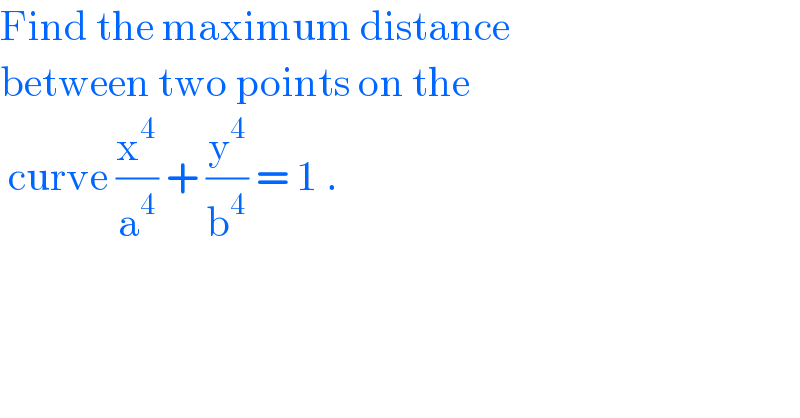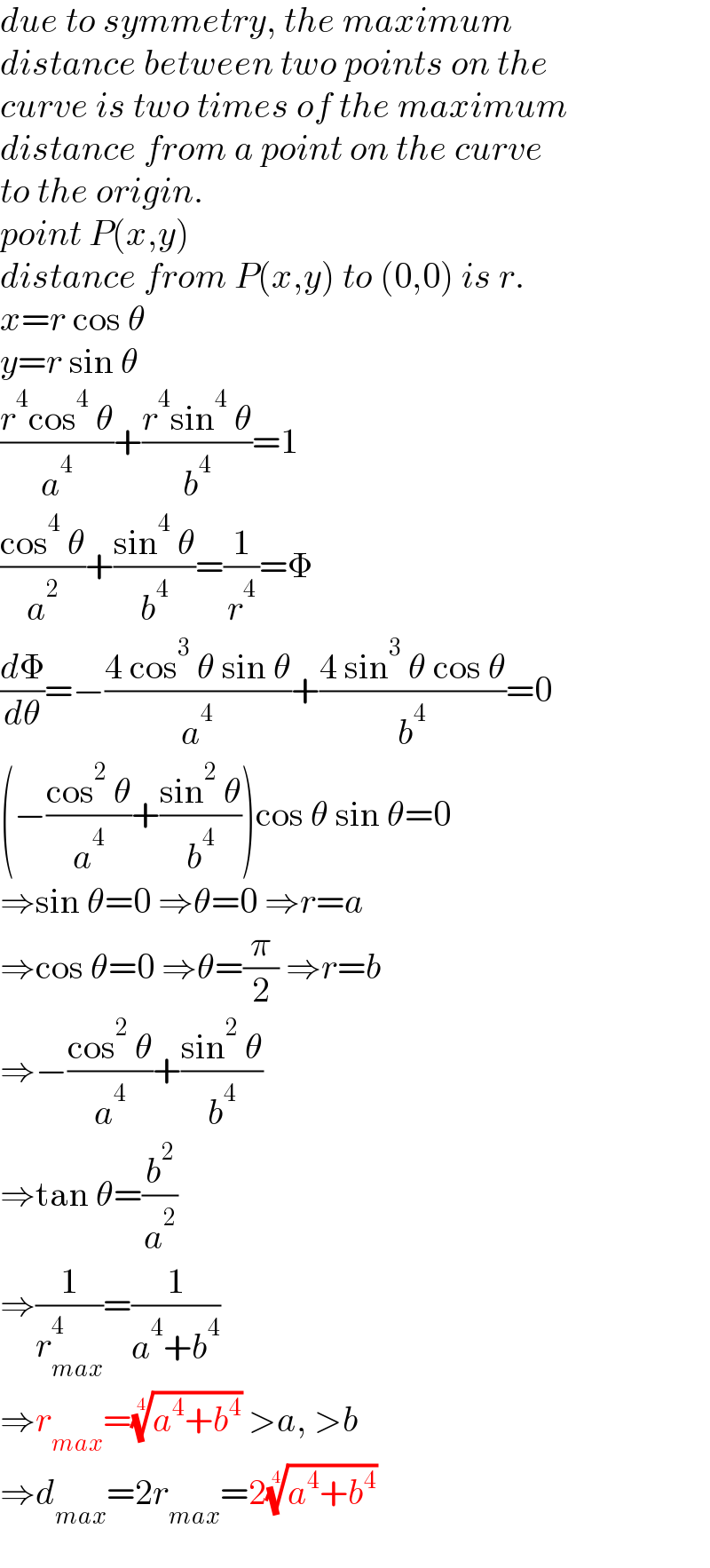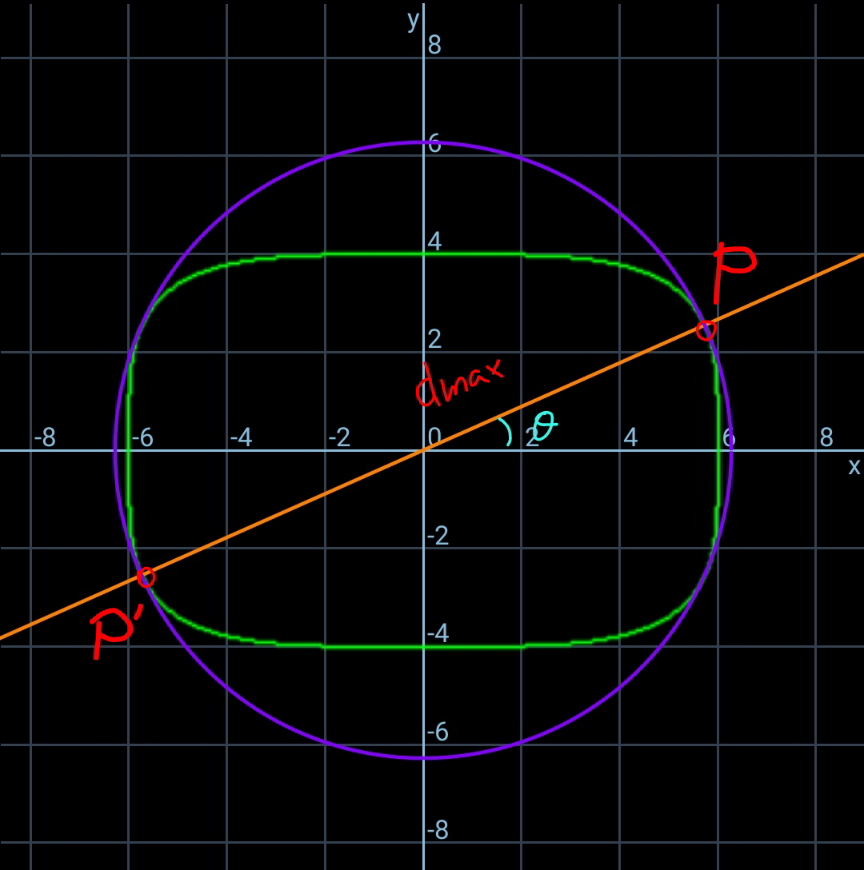Question Number 144995 by liberty last updated on 01/Jul/21

$$\mathrm{Find}\:\mathrm{the}\:\mathrm{maximum}\:\mathrm{distance}\: \\ $$$$\mathrm{between}\:\mathrm{two}\:\mathrm{points}\:\mathrm{on}\:\mathrm{the}\: \\ $$$$\:\mathrm{curve}\:\frac{\mathrm{x}^{\mathrm{4}} }{\mathrm{a}^{\mathrm{4}} }\:+\:\frac{\mathrm{y}^{\mathrm{4}} }{\mathrm{b}^{\mathrm{4}} }\:=\:\mathrm{1}\:. \\ $$
Answered by mr W last updated on 01/Jul/21

$${due}\:{to}\:{symmetry},\:{the}\:{maximum}\: \\ $$$${distance}\:{between}\:{two}\:{points}\:{on}\:{the} \\ $$$${curve}\:{is}\:{two}\:{times}\:{of}\:{the}\:{maximum} \\ $$$${distance}\:{from}\:{a}\:{point}\:{on}\:{the}\:{curve} \\ $$$${to}\:{the}\:{origin}. \\ $$$${point}\:{P}\left({x},{y}\right) \\ $$$${distance}\:{from}\:{P}\left({x},{y}\right)\:{to}\:\left(\mathrm{0},\mathrm{0}\right)\:{is}\:{r}. \\ $$$${x}={r}\:\mathrm{cos}\:\theta \\ $$$${y}={r}\:\mathrm{sin}\:\theta \\ $$$$\frac{{r}^{\mathrm{4}} \mathrm{cos}^{\mathrm{4}} \:\theta}{{a}^{\mathrm{4}} }+\frac{{r}^{\mathrm{4}} \mathrm{sin}^{\mathrm{4}} \:\theta}{{b}^{\mathrm{4}} }=\mathrm{1} \\ $$$$\frac{\mathrm{cos}^{\mathrm{4}} \:\theta}{{a}^{\mathrm{2}} }+\frac{\mathrm{sin}^{\mathrm{4}} \:\theta}{{b}^{\mathrm{4}} }=\frac{\mathrm{1}}{{r}^{\mathrm{4}} }=\Phi \\ $$$$\frac{{d}\Phi}{{d}\theta}=−\frac{\mathrm{4}\:\mathrm{cos}^{\mathrm{3}} \:\theta\:\mathrm{sin}\:\theta}{{a}^{\mathrm{4}} }+\frac{\mathrm{4}\:\mathrm{sin}^{\mathrm{3}} \:\theta\:\mathrm{cos}\:\theta}{{b}^{\mathrm{4}} }=\mathrm{0} \\ $$$$\left(−\frac{\mathrm{cos}^{\mathrm{2}} \:\theta}{{a}^{\mathrm{4}} }+\frac{\mathrm{sin}^{\mathrm{2}} \:\theta}{{b}^{\mathrm{4}} }\right)\mathrm{cos}\:\theta\:\mathrm{sin}\:\theta=\mathrm{0} \\ $$$$\Rightarrow\mathrm{sin}\:\theta=\mathrm{0}\:\Rightarrow\theta=\mathrm{0}\:\Rightarrow{r}={a} \\ $$$$\Rightarrow\mathrm{cos}\:\theta=\mathrm{0}\:\Rightarrow\theta=\frac{\pi}{\mathrm{2}}\:\Rightarrow{r}={b} \\ $$$$\Rightarrow−\frac{\mathrm{cos}^{\mathrm{2}} \:\theta}{{a}^{\mathrm{4}} }+\frac{\mathrm{sin}^{\mathrm{2}} \:\theta}{{b}^{\mathrm{4}} } \\ $$$$\Rightarrow\mathrm{tan}\:\theta=\frac{{b}^{\mathrm{2}} }{{a}^{\mathrm{2}} } \\ $$$$\Rightarrow\frac{\mathrm{1}}{{r}_{{max}} ^{\mathrm{4}} }=\frac{\mathrm{1}}{{a}^{\mathrm{4}} +{b}^{\mathrm{4}} } \\ $$$$\Rightarrow{r}_{{max}} =\sqrt[{\mathrm{4}}]{{a}^{\mathrm{4}} +{b}^{\mathrm{4}} }\:>{a},\:>{b} \\ $$$$\Rightarrow{d}_{{max}} =\mathrm{2}{r}_{{max}} =\mathrm{2}\sqrt[{\mathrm{4}}]{{a}^{\mathrm{4}} +{b}^{\mathrm{4}} } \\ $$
Commented by mr W last updated on 01/Jul/21

